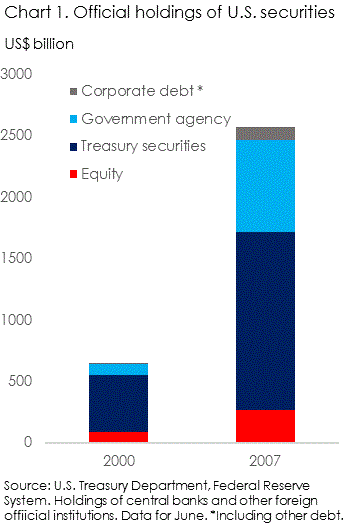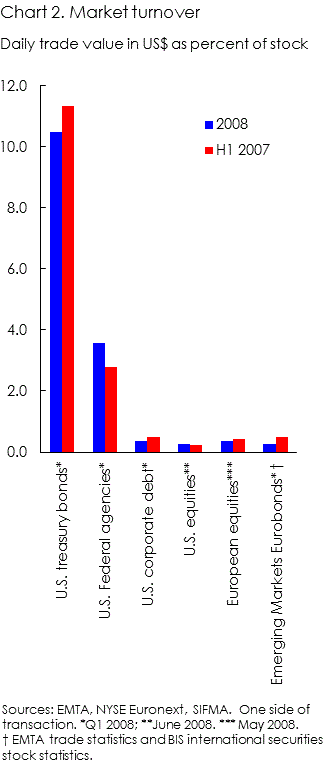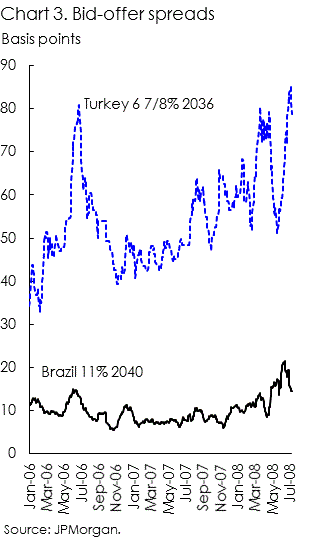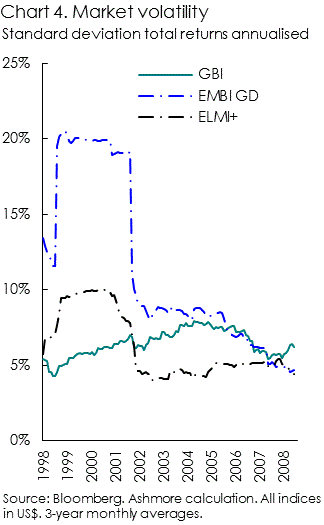Central banks and emerging markets liquidity
27 July 2008
Ousmène Mandeng, Ashmore Investment Management
Central banks have traditionally attached a high priority to market liquidity for the investment of their foreign exchange reserves. This is due in part to criteria governing the definition of central bank reserves. While many central banks have tiered their reserves to allow differential allocation criteria and investment horizons, liquidity considerations have remained important. Very large central banks contemplating building sizeable portfolios in emerging markets assets, generally in excess of US$10 billion, are concerned that they would have to overly compromise on liquidity and that significant allocations may cause unwanted price movements. Central banks therefore risk resisting entering emerging markets altogether if feasible allocations are insufficient to make a difference in their overall portfolios or require a disproportional amount of institutional resources to be redeployed. However, partial data suggest that central banks have already diversified their reserve assets into securities whose market liquidity is comparable to that of emerging markets assets.
The adequate measure of liquidity remains most controversial. The finance literature provides different approaches to measure liquidity and there is no agreement of what constitutes sufficient liquidity. Investors normally understand sufficient liquidity to be the ability to conduct large transactions without unduly affecting the price. Liquidity is also normally associated with low transaction costs. Per market segment, those factors normally depend on the size of the float relative to the size of the transaction.
Holdings of U.S. securities show that the official sector has diversified its assets significantly over the past few years (Chart 1). The core of official holdings is still represented by U.S. treasury securities. However, agency and corporate debt have increased substantially as a share in total holdings with official holdings of U.S. corporate debt having increased more than six-fold since 2000; the share of equities has remained broadly stable albeit at a high level.
Market liquidity differs substantially between different U.S. securities markets. While the U.S. treasury bond market is considered to be one of the most liquid; in comparison agency and corporate debt and equities are far less liquid when measuring the daily turn-over volume relative to the stock of outstanding securities (Chart 2).
The U.S. corporate debt market is estimated to be in large part fairly illiquid with reports showing that the average number of daily trades in an issue is only 2.4 and that while representing 20 percent of outstanding U.S. bonds only accounts for 2.5 to 3.0 percent of trading activity; trading costs also tend to be much higher as, except for the largest most actively traded bonds, only few dealers make a market.1 The New York Stock Exchange also exhibits trading volumes relative to the stock of equity securities outstanding that are relatively small. Even the U.S. treasury bond market shows liquidity to be highly concentrated with on-the-run issues representing about 80 percent of treasury trading volumes.2
Emerging markets trade volume data suggest that they compare favorably with U.S. corporate debt data (see Chart 2).3/span> Similarly, the BIS reported that “liquidity is improving in many markets in the [emerging markets economies]. […] In 2005, the ratio of turnover to outstanding stocks in some emerging markets (for instance, Chile, Poland, South Africa and Taiwan (China)) was comparable to that in mature markets […].”4 This is also supported by the inclusion of several emerging markets in key global market indices.5 Euroclear recently announced the adoption of an additional nine settlement currencies, all of which are emerging markets currencies, highlighting mounting international integration of emerging markets capital markets securities. Anecdotal observations also support the view that many emerging markets are liquid; e.g. the Mexican and Polish local bond markets have average daily turn-overs of US$6 billion and US$2 billion, respectively.
Bid-offer spreads, as a proxy for transaction costs, have shown consistently low levels for the most liquid instruments of higher grade emerging markets securities while bid-offer spreads of lower grade issues have been higher and more variable (Chart 3). In terms of volatility, seen as a key indicator for liquidity as a liquid market should allow asset prices to adjusted smoothly, emerging markets levels of volatility have converged with the level of volatility of benchmark industrialized countries government bond indices (Chart 4).
Emerging markets are unlikely to provide substitutes for the most liquid market instruments in the near future. Allocations to emerging markets assets have been motivated mostly by diversification objectives and guided by investment rather then by need-for-intervention criteria. As such, the investment horizon for emerging markets assets tend to be longer and the built-up of an emerging markets portfolio would typically require some time. Very large central banks may consider pre-announced allocation targets, similar in spirit to the central bank gold agreements of 1999 and 2004.6
The large holdings of U.S. equities by the official sector reveal that the official sector is willing to give up substantial liquidity to achieve a more balanced portfolio. While central banks will continue to consider liquidity as important, corporate debt and equities represent already 4 and 10 percent of official holdings of U.S. securities. As emerging markets market capitalization continues to grow rapidly, relative liquidity will also shift. In that regard, liquidity should not be the argument to prevent emerging markets securities from making up at least as much corporate debt and equities in a representative central bank foreign exchange portfolio.



1 Bessembinder, H. and Maxwell, W., “Transparency and the Corporate Bond Market," Journal of Economic Perspectives (forthcoming), 2008. See also Bao, J. et al, “Liquidity of Corporate Bonds,” MIT Sloan School of Management,” mimeo, March 2008.
2 Mizrach, B. and Neely, C., “The microstructure of the U.S. treasury market,” Working Paper 2007-052B, Federal Reserve Bank of St. Louis, April 2008.
3 EMTA data are likely to underestimate turn-over though as they only capture effectively trading activity of non-resident entities.
4 CGFS Papers No 28, “Financial stability and local currency bond markets,” BIS June 2007.
5 Czech Republic, Hong-Kong, Hungary, Korea, Mexico, Poland and South Africa are part of the JPMorgan Government Bond Index Broad that is subject to relative liquidity ratings for inclusion.
6 An agreement of pre-agreed and announced annual and five-year ceilings for selling gold subscribed by key central banks.